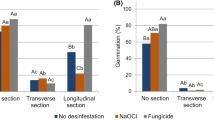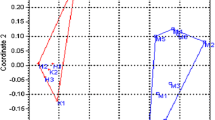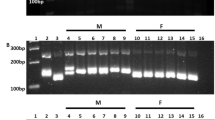Abstract
Brazil is currently the worlds largest producer of papaya (Carica papayaL.), producing fruits for both the domestic market and export. Only fruits from hermaphrodite plants are marketed because they have the necessary commercial characteristics, i.e. they are pear-shaped and have thicker flesh and a smaller internal cavity. Increased papaya yield has been limited mainly by the ratio of female to hermaphrodite (1: 2) plants normally occurring in orchards. This ratio causes great losses to papaya producers and the identification of the sex of seedlings during the nursery stage would be an important advance. In our study random amplified polymorphic DNA (RAPD) analysis was used to differentiate between the sexual forms of three commercial C. papaya cultivars belonging to the Solo group. RAPD assays using the BC210 primer were able to detect hermaphrodites in all of the cultivars tested. The BC210438molecular marker was much better at papaya sex differentiation than other markers described in the literature.
Similar content being viewed by others
References
Alstrom-Rapaport, C., M. Lascoux, Y.C. Wang, G. Roberts & G.A. Tuskan, 1998. Identification of a RAPD marker linked to sex determination in the basket willow (Salix viminalis L.). J Hered 89: 44–49.
Andreani Jr, R. & E.G.M. Lemos, 1995. Utilização do sistema peroxidase na determinação do sexo em plantas de mamoeiro (Carica papaya L.). Rev Bras Gen 18: 251.
Awada, M. & W. Ikeda, 1957. Effects of water and nitrogen on composition, growth, sugar in fruits yield and sex expression of the papaya plants (Carica papaya L.). Hawaii Agric Exp Sta Tech Bull No 33.
Awada, M., 1958. Relationships of minimum temperature and growth rate with sex expression of papaya plants (Carica papaya L.). Hawaii Agric Exp Sta Tech Bull No 38.
Food and Agriculture Organization (FAO), 1998. Production yearbook. Food and Agriculture Organization of the United Nations. Rome.
Ghosh, S.P. & S.P. Sen, 1975. The modification of sex expression in papaya (Carica papaya L.). J Hort Sci 50: 91–96.
Hofmeyr, J.D.J., 1938. Genetical studies of Carica papaya L. S Afr J Sci 35: 300–304.
Jobin-Decor, M.P., G.C. Graham, R.J. Henry & R.A. Drew, 1997. RAPD and isozyme analysis of genetic relationships between Carica papaya and wild relatives. Genet Res Crop Evol 44: 471–477.
Magdalita, P.M., R.A. Drew, S.W. Adkins & I.D. Godwin, 1997. Morphological, molecular and cytological analyses of Carica papaya ?C. cauliflora interspecific hybrids. Theor Appl Genet 95: 224–229.
Marin, S.L.D. & J.A. Gomes, 1987. Sexagem do mamoeiro e sua aplicação no desbaste de plantas. Empresa Capixaba de Pesquisa Circular Técnica No 11.
Morshidi, M., 1998. Genetic control of isozymes in Carica papaya L. Euphytica 103: 89–94.
Saghai-Maroof, M.A., K. Soliman, R.A. Jorgensen & R.W. Allard, 1984. Ribosomal DNA spacer-length polymorphisms in barley: mendelian inheritance, chromosomal location, and population dynamics. Proc Natl Acad Sci USA 81: 8014–8018.
Sambrook, J., T. Maniatis & E.F. Fritsch, 1989. Molecular Cloning: A Laboratory Manual. Cold Spring Harbor Laboratory Press, New York.
Sharon, D., J. Hillel, A. Vainstein & U. Lavi, 1992. Application of DNA fingerprints for identification and genetic analysis of Carica papaya and other Carica species. Euphytica 62: 119–126.
Soltis, D.E. & P.S. Soltis, 1989. Isozymes in Plant Biology. Dioscorides Press, Portland Oregon.
Sondur, S.N., R.M. Manshardt & J.I. Stiles, 1996. A genetic linkage map of papaya based on randomly amplified polymorphic DNA markers. Theor Appl Genet 93: 547–553.
Stiles, J.I., C. Lemme, S. Sondur, M.B. Morshidi & R. Manshardt, 1993. Using randomly amplified polymorphic DNA for evaluating genetic relationships among papaya cultivars. Theor Appl Genet 85: 697–701.
Storey, W.B., 1938. Segregation of sex types in Solo papaya and their application to the selection of seed. J Amer Soc Hort Sci 35: 83–85.
Storey, W.B., 1976. Papaya. In: N.W. Simmonds (Ed.), Evolution of Crop Plants, pp. 21–24. Longman, San Francisco.
Author information
Authors and Affiliations
Rights and permissions
About this article
Cite this article
Lemos, E.G.M., Silva, C.L.S.P. & Zaidan, H.A. Identification of sex in Carica papaya L. using RAPD markers. Euphytica 127, 179–184 (2002). https://doi.org/10.1023/A:1020269727772
Issue Date:
DOI: https://doi.org/10.1023/A:1020269727772




